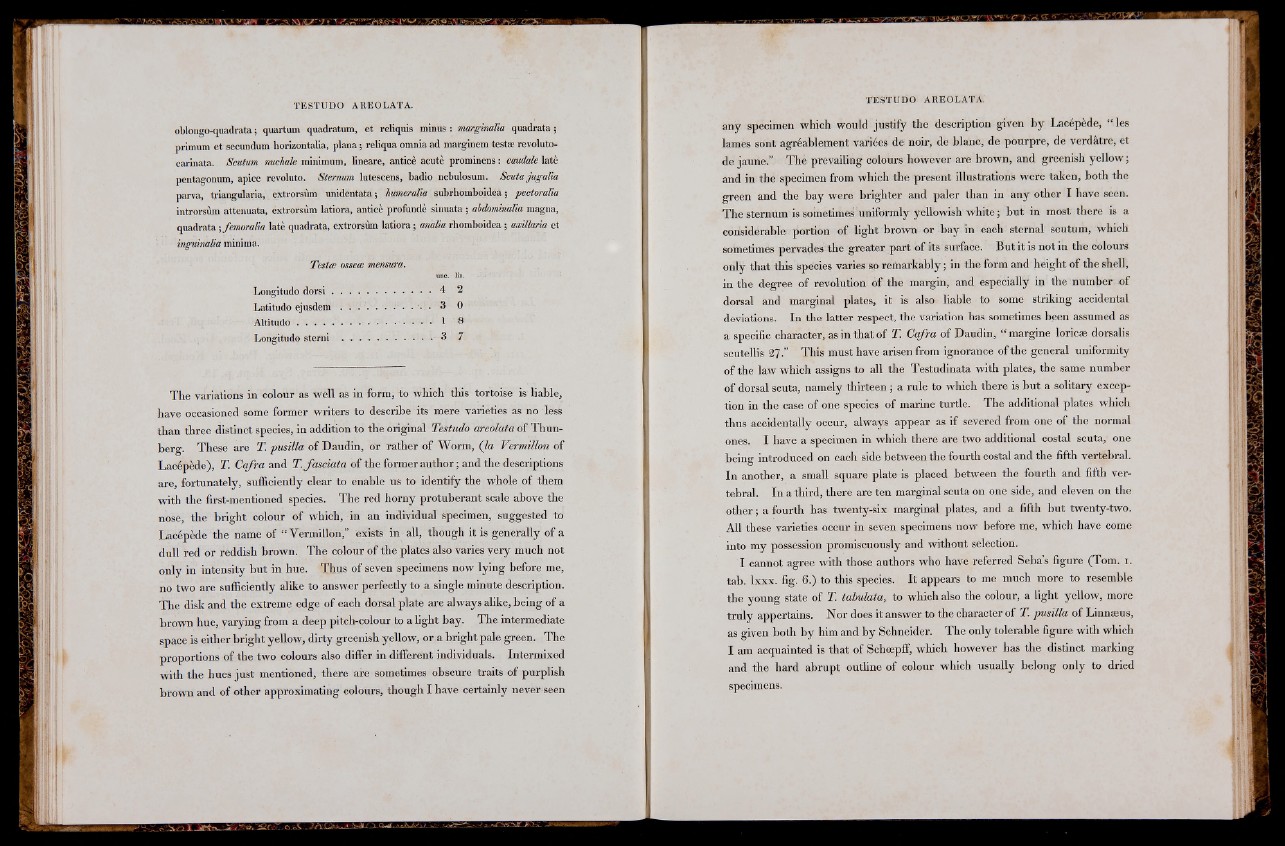
TESTUDO AREOLATA.
oblongo-quadrata ; quartum quadratimi, et reliquis minus : marginalia quadrata ;
jirimum et secundum horizontalia, plana ; reliqua omnia ad marginem test* revoluto-
carinata. Scutum nuchale minimum, lineare, anticè acutè prominens : caudale latè
pentagonum, apice revoluto. Sternum lutescens, badio nebulosum. Scuta jugalia
parva, triangularía, extrorsùm unidentata ; humeralia subrhomboidea ; pectoralia
introrsùm attenuata, extrorsùm latiora, anticè profonde sinuata ; abdominalia magna,
quadrata ; femoralia latè quadrata, extrorsùm latiora ; amila rhomboidea ; anillaría et
inguinalìa minima.
Testce ossea: mensura.
une. lin. '
Longitudo d o r s i ........................................4 2
Latitudo ejusdem . : . . . 3 0
A ltitu d o .......................................... 1 8
Longitudo sterni .................................... 3 7
The variations in colour as well as in form, to which this tortoise is liable,
have occasioned some former writers to describe its mere varieties as no less
than three distinct species, in addition to the original Testudo areolata of Thun-
berg. These are T. pusilla of Daudin, or rather of Worm, (la Vermilion of
Lacepede), T. Cqfra and T.fasciata of the former author; and the descriptions
are, fortunately, sufficiently clear to enable us to identify the whole of them
with the first-mentioned species. The red horny protuberant scale above the
nose, the bright colour of which, in an individual specimen, suggested to
Lacepede the name of “ Vermilion,” exists in all, though it is generally of a
dull red or reddish brown. The colour of the plates also varies very much not
only in intensity but in hue. Thus of seven specimens now lying before me,
no two are sufficiently alike to answer perfectly to a single minute description.
The disk and the extreme edge of each dorsal plate are always alike, being of a
brown hue, varying from a deep pitch-colour to a light bay. The intermediate
space is either bright yellow, dirty greenish yellow, or a bright pale green. The
proportions of the two colours also differ in different individuals. Intermixed
with the hues just mentioned, there are sometimes obscure traits of purplish
brown and of other approximating colours, though I have certainly never seen
TESTUDO AREOLATA.
any specimen which would justify the description given by Lacépède, “ les
lames sont agréablement variées de noir, de blanc, de pourpre, de verdâtre, et
de jaune.” Thè prevailing colours however are brown, and greenish yellow ;
and in the specimen from which the present illustrations were taken, both the
green and the bay were brighter and paler than in any other I have seen.
The sternum is sometimes uniformly yellowish white; but in most there is a
considérable portion of light brown or bay in each sternal scutum, which
sometimes pervades the greater part of its surface. But it is not in the colours
only that this species varies so remarkably ; in the form and height of the shell,
in the degree of revolution óf the margin, and especially in the number of
dorsal and marginal plates, it is also liable to some striking accidental
deviations. In the latter respect, the variation has sometimes been assumed as
a specific character, as in that of T. Cqfra of Daudin, “ margine loricæ dorsalis
scutellis 27;?’ ’ This must have arisen from ignorance of the general uniformity
of the law which assigns to all the Testudinata with plates, the same number
of dorsal scuta, namely thirteen ; a rule to which there is but a solitary exception
in the Case, of one species of marine turtle. The additional plates which
thus accidentally occur, always appear as if severed from one of the normal
ones. I have a specimen in which there are two additional costal scuta,’ one
being introduced on each side between the fourth costal and the fifth vertebral.
In another, a small square plate is placed between the fourth and fifth vertebral.
In a third, there are ten marginal scuta on one side, and eleven on the
other ; a fourth has twenty-six marginal plates, and a fifth but twenty-two.
All these varieties occur in seven specimens now before me, which have come
into my possession promiscuously and without selection.
I cannot agree with those, authors who have referred Sebas figure (Tom. i.
tab. lxxx. fig. 6.) to this species. It appears to me much more to resemble
the young state of T. tabulata, to which also the colour, a light yellow, more
truly appertains. Nor does it answer to the character of T. pusilla of Linnæus,
as given both by him and by Schneider. The only tolerable figure with which
I am acquainted is that of Schoepff, which however has the distinct marking
and the hard abrupt outline of colour which usually belong only to dried
specimens.